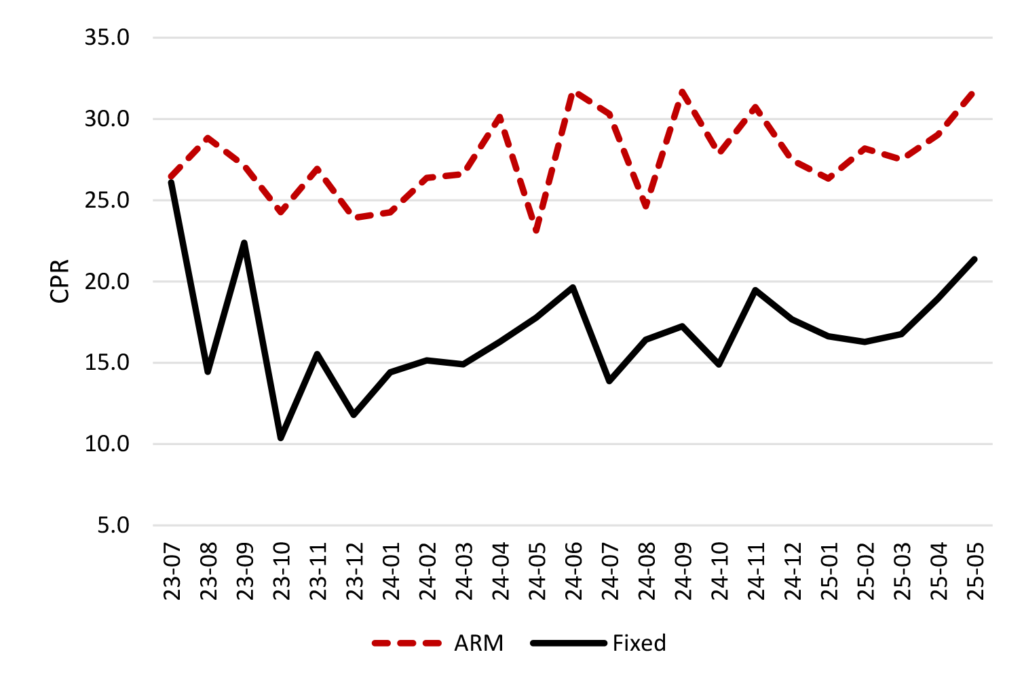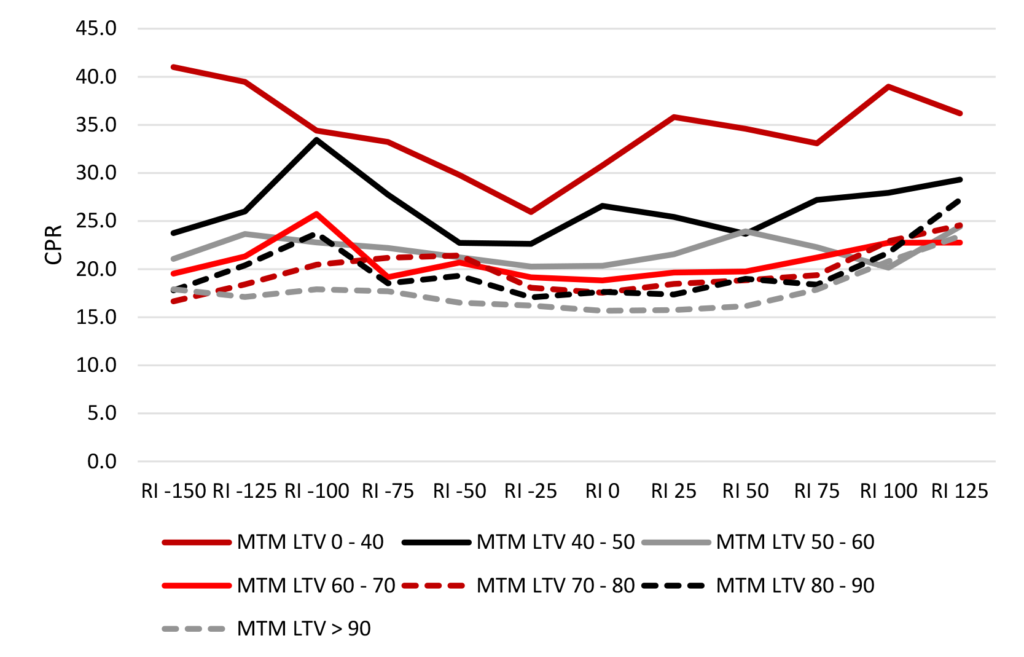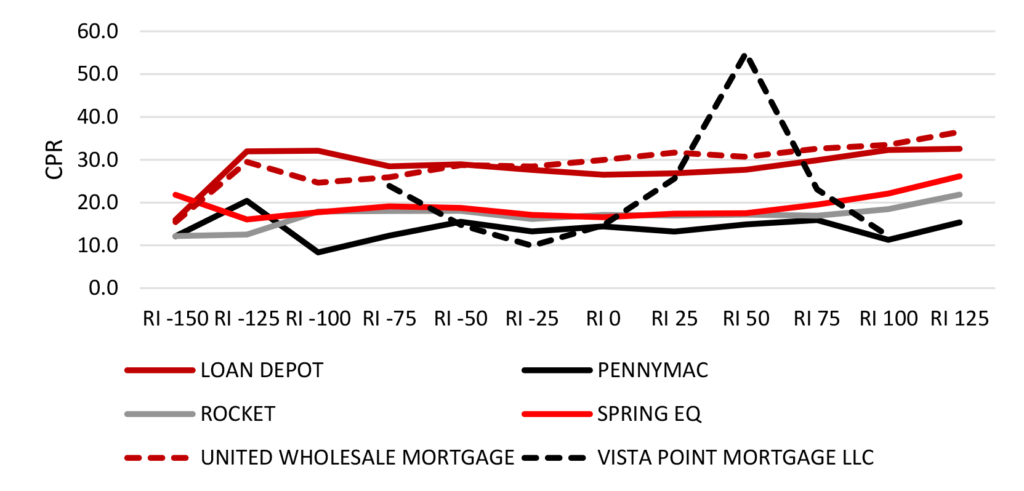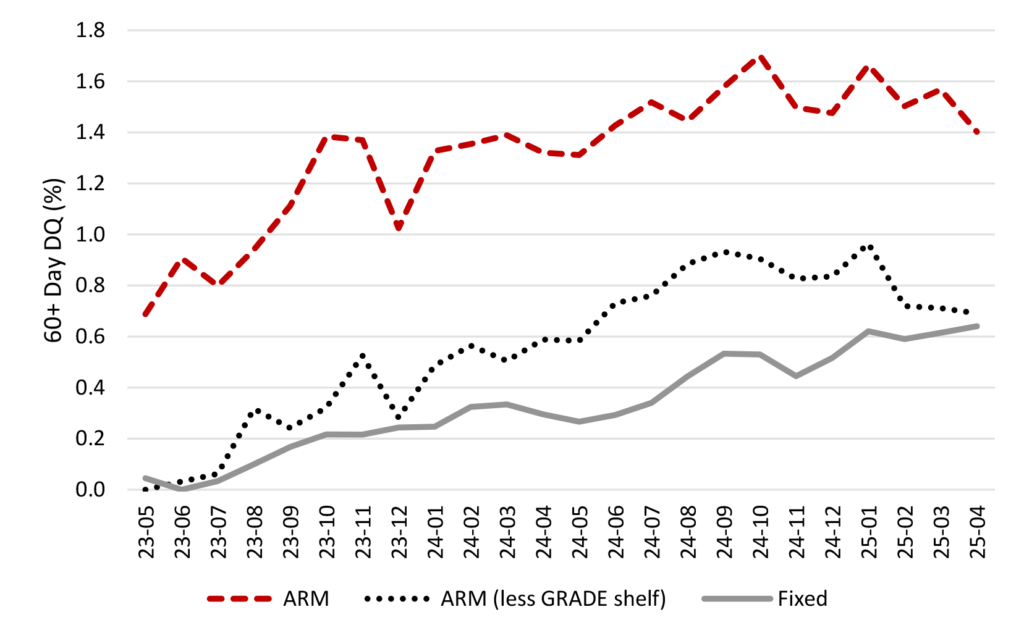By the Numbers
Tracking prepayments and credit across second-lien mortgages
This document is intended for institutional investors and is not subject to all of the independence and disclosure standards applicable to debt research reports prepared for retail investors. This material does not constitute research.
Second-lien mortgage loans continue to offer performance marked by low delinquency rates and steady prepayments. But while overall performance remains strong, there are some noticeable differences. Closed-end second liens are largely performing better than floating-rate HELOCs when evaluating both prepayments and credit. Within closed-end second liens, loans originated by Rocket and PennyMac offer attractive convexity with flat prepayment S-curves at relatively muted absolute speeds.
Breaking down second lien prepayment performance
The first and most noticeable difference in prepayment behavior across securitized second liens is that floating-rate HELOCs are prepaying faster than fixed-rate, closed-end second liens. Cohort level speeds for HELOCs were 10 CPR faster than fixed-rate seconds in May, with the cohorts prepaying at 31 and 21 CPR respectively (Exhibit 1). This prepayment difference is consistent with the overwhelming majority of observations over the past two years.
Relatively muted refinancing activity across second-lien collateral with substantial incentive is likely due to two main factors. First, loan balances remain relatively small across securitized second lien collateral, making fixed origination costs substantial as a percentage of the loan balance. Estimates of origination costs including appraisals or AVMs, processing fees, margin and other closing costs imply that these costs could be upwards of 300 bp on a $100,000, slightly larger than the average size of loans securitized in recent vintage CES transactions. Additionally, elevated first-lien mortgage rates have afforded second lien borrowers with limited opportunities to refinance and consolidate their liens into a larger consolidated first lien with incentive versus the blended rate of their existing first and second liens.
Exhibit 1: HELOC collateral prepays faster than fixed-rate second liens

Source: Santander US Capital, Core Logic Loan Performance
Observations of elevated prepayment speeds in second-lien collateral appear to be primarily a function of larger stores of borrower equity as loans with lower mark-to-market CLTVs are prepaying substantially faster than higher CLTV ones (Exhibit 2). One plausible explanation for faster speeds across lower mark-to-market CTLV loans may be substantial refinancing incentive. While all originators maintain their own proprietary risk-based pricing grids, loan-level pricing adjustments may be anywhere from one to three points difference between higher CLTV loans and lower ones. Assuming a roughly 3-year duration on the loan cash-flow LTV related refinancing incentive could range from roughly 3/8ths of a point to one point depending on borrowers’ credit scores.
Exhibit 2: Borrower equity drives elevated prepayments in second liens

Source: Santander US Capital, Core Logic Loan Performance
Cutting the universe of securitized second liens by some of the largest originators shows that while all originators analyzed exhibit flat prepayment S-curves, certain originators stand out. PennyMac, Rocket and SpringEQ show speeds roughly in-line with pricing conventions both in and out of the money. Conversely, second liens originated by United Wholesale and Loan Depot are paying more than 10 CPR faster at-the-money than other originators, prepaying at 30 CPR and 26.5 CPR respectively at-the-money (Exhibit 3).
Exhibit 3: United Wholesale, Loan Depot second liens prepay faster than other originators

Source: Santander US Capital, Core Logic Loan Performance
A look at credit
Credit performance across second lien collateral remains strong. Serious delinquency rates across the combined cohort of both fixed-rate, closed-end second liens and HELOCs sit at just 80 bp. With that said, certain credit characteristics are showing some signs of modestly elevated delinquency rates. Closed-end second liens are performing modestly better than HELOCs, with 60+ day delinquency rates of 64 bp and 140 bp respectively. However, elevated delinquency rates in the HELOC cohort are being driven, in large part, by more seasoned loans securitized in the Saluda Grade GRADE shelf. When excluding the more seasoned GRADE deals from the floating-rate cohort, serious delinquency rates fall roughly in-line with those of fixed-rate loans (Exhibit 4).
Exhibit 4: Comparing delinquency rates across fixed and floating-rate second liens

Source: Santander US Capital, Core Logic Loan Performance
Credit characteristics that are showing relative weakness include loan term and underwriting. Longer-maturity second liens are performing noticeably worse than those with shorter ones. Delinquency rates on 30-year second liens sit at 188 bp with 15- and 20-year cohorts at 23 bp and 48 bp respectively. The 30-year cohort is somewhat more seasoned than the shorter-term loans, suggesting that elevated delinquencies may be a function of the loans being further up a CDR ramp. However, when controlling for WALA, looking exclusively at loans 0-12 WALA for each cohort shows an even more pronounced difference in performance. Serious delinquency rates on recently originated 30-year second liens sit at 280 bp, with 15-year collateral sitting at 63 bp and 10-year collateral at 79 bp.
One other notable difference in performance can be seen in underwriting where delinquency rates on fully documented loans are markedly lower than those using alternative documentation. Admittedly, the cohort of ‘non-QM’ second liens is relatively small, potentially lending observations to being overstated given relatively small samples of loans. With that said, delinquency rates on these loans currently sit at 227 bp while fully documented seconds are just 54 bp. Fully documented second liens may also benefit, in many cases, from being sourced by originators who service the existing first lien, giving them better transparency into the combined mortgage debt burden and prior payment velocity of the borrower.
This material is intended only for institutional investors and does not carry all of the independence and disclosure standards of retail debt research reports. In the preparation of this material, the author may have consulted or otherwise discussed the matters referenced herein with one or more of SCM’s trading desks, any of which may have accumulated or otherwise taken a position, long or short, in any of the financial instruments discussed in or related to this material. Further, SCM may act as a market maker or principal dealer and may have proprietary interests that differ or conflict with the recipient hereof, in connection with any financial instrument discussed in or related to this material.
This message, including any attachments or links contained herein, is subject to important disclaimers, conditions, and disclosures regarding Electronic Communications, which you can find at https://portfolio-strategy.apsec.com/sancap-disclaimers-and-disclosures.
Important Disclaimers
Copyright © 2025 Santander US Capital Markets LLC and its affiliates (“SCM”). All rights reserved. SCM is a member of FINRA and SIPC. This material is intended for limited distribution to institutions only and is not publicly available. Any unauthorized use or disclosure is prohibited.
In making this material available, SCM (i) is not providing any advice to the recipient, including, without limitation, any advice as to investment, legal, accounting, tax and financial matters, (ii) is not acting as an advisor or fiduciary in respect of the recipient, (iii) is not making any predictions or projections and (iv) intends that any recipient to which SCM has provided this material is an “institutional investor” (as defined under applicable law and regulation, including FINRA Rule 4512 and that this material will not be disseminated, in whole or part, to any third party by the recipient.
The author of this material is an economist, desk strategist or trader. In the preparation of this material, the author may have consulted or otherwise discussed the matters referenced herein with one or more of SCM’s trading desks, any of which may have accumulated or otherwise taken a position, long or short, in any of the financial instruments discussed in or related to this material. Further, SCM or any of its affiliates may act as a market maker or principal dealer and may have proprietary interests that differ or conflict with the recipient hereof, in connection with any financial instrument discussed in or related to this material.
This material (i) has been prepared for information purposes only and does not constitute a solicitation or an offer to buy or sell any securities, related investments or other financial instruments, (ii) is neither research, a “research report” as commonly understood under the securities laws and regulations promulgated thereunder nor the product of a research department, (iii) or parts thereof may have been obtained from various sources, the reliability of which has not been verified and cannot be guaranteed by SCM, (iv) should not be reproduced or disclosed to any other person, without SCM’s prior consent and (v) is not intended for distribution in any jurisdiction in which its distribution would be prohibited.
In connection with this material, SCM (i) makes no representation or warranties as to the appropriateness or reliance for use in any transaction or as to the permissibility or legality of any financial instrument in any jurisdiction, (ii) believes the information in this material to be reliable, has not independently verified such information and makes no representation, express or implied, with regard to the accuracy or completeness of such information, (iii) accepts no responsibility or liability as to any reliance placed, or investment decision made, on the basis of such information by the recipient and (iv) does not undertake, and disclaims any duty to undertake, to update or to revise the information contained in this material.
Unless otherwise stated, the views, opinions, forecasts, valuations, or estimates contained in this material are those solely of the author, as of the date of publication of this material, and are subject to change without notice. The recipient of this material should make an independent evaluation of this information and make such other investigations as the recipient considers necessary (including obtaining independent financial advice), before transacting in any financial market or instrument discussed in or related to this material.
Important disclaimers for clients in the EU and UK
This publication has been prepared by Trading Desk Strategists within the Sales and Trading functions of Santander US Capital Markets LLC (“SanCap”), the US registered broker-dealer of Santander Corporate & Investment Banking. This communication is distributed in the EEA by Banco Santander S.A., a credit institution registered in Spain and authorised and regulated by the Bank of Spain and the CNMV. Any EEA recipient of this communication that would like to affect any transaction in any security or issuer discussed herein should do so with Banco Santander S.A. or any of its affiliates (together “Santander”). This communication has been distributed in the UK by Banco Santander, S.A.’s London branch, authorised by the Bank of Spain and subject to regulatory oversight on certain matters by the Financial Conduct Authority (FCA) and the Prudential Regulation Authority (PRA).
The publication is intended for exclusive use for Professional Clients and Eligible Counterparties as defined by MiFID II and is not intended for use by retail customers or for any persons or entities in any jurisdictions or country where such distribution or use would be contrary to local law or regulation.
This material is not a product of Santander´s Research Team and does not constitute independent investment research. This is a marketing communication and may contain ¨investment recommendations¨ as defined by the Market Abuse Regulation 596/2014 ("MAR"). This publication has not been prepared in accordance with legal requirements designed to promote the independence of research and is not subject to any prohibition on dealing ahead of the dissemination of investment research. The author, date and time of the production of this publication are as indicated herein.
This publication does not constitute investment advice and may not be relied upon to form an investment decision, nor should it be construed as any offer to sell or issue or invitation to purchase, acquire or subscribe for any instruments referred herein. The publication has been prepared in good faith and based on information Santander considers reliable as of the date of publication, but Santander does not guarantee or represent, express or implied, that such information is accurate or complete. All estimates, forecasts and opinions are current as at the date of this publication and are subject to change without notice. Unless otherwise indicated, Santander does not intend to update this publication. The views and commentary in this publication may not be objective or independent of the interests of the Trading and Sales functions of Santander, who may be active participants in the markets, investments or strategies referred to herein and/or may receive compensation from investment banking and non-investment banking services from entities mentioned herein. Santander may trade as principal, make a market or hold positions in instruments (or related derivatives) and/or hold financial interest in entities discussed herein. Santander may provide market commentary or trading strategies to other clients or engage in transactions which may differ from views expressed herein. Santander may have acted upon the contents of this publication prior to you having received it.
This publication is intended for the exclusive use of the recipient and must not be reproduced, redistributed or transmitted, in whole or in part, without Santander’s consent. The recipient agrees to keep confidential at all times information contained herein.






